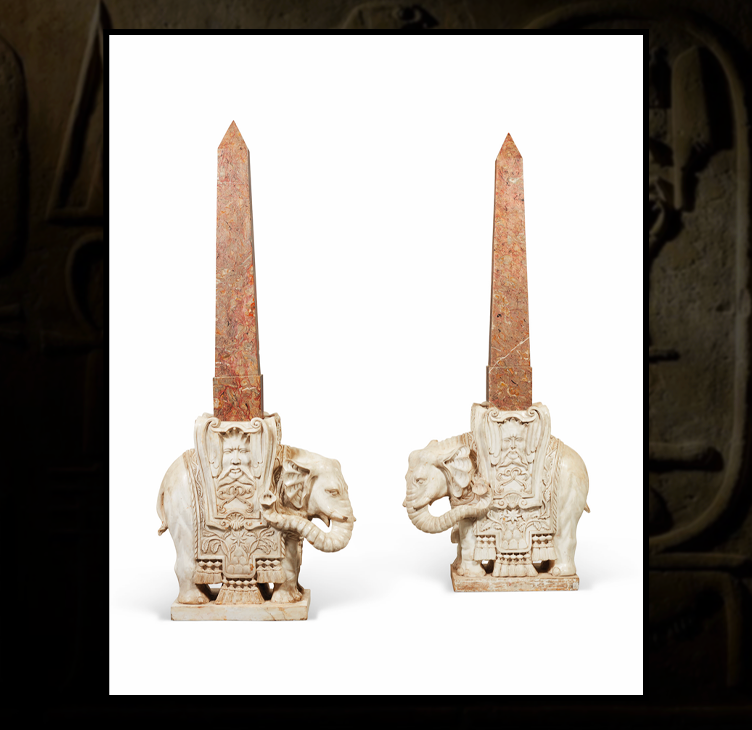Obelisk, the legend of a sacred stone
The origin or function of an obelisk remains to this day mysterious and subject to interpretation as the old Egyptian Civilization didn’t leave behind them any clear theory that could answer these questions.
First of all, the creation and use of obelisks stem from a prehistoric cult of erected stones which took many forms across the globe such as menhirs in France.
Entrance of Luxor Temple, circa 1800
Watercolor by François-Charles Cécile (1766-1840)
© RMN-Grand Palais (musée du Louvre)/Les frères Chuzeville
Félix Teynard
Photograph Of Luxor Temple, 1851
© MET Museum
In Egypt the first obelisk was erected in Heliopolis, known as the “city of sun”, which was once one of the major cities in Egypt. At this time the Obelisk was seen as an object that aimed to captivate the energy of the sun, at his spike the sun was rising and setting everyday and it was itself probably representing a sun ray.
It was also viewed as the element linking the ground, the terrestrial universe, from where it was erected and the divine world with its pyramidion heading towards the sky.
A unusual neoclassical obelisk
Porcelain bisque, decorated with hieroglyphs
© Artcurial
A French Ormolu and Patinated Bronze Obelisk
Second Half 19th Century
© Christie’s
Pair of Late 19th century Marble Obelisk
Based on models by Gian Lorenzo Bernini in the Piazza della Minerva in Rome
© Christie’s
A Louis-Philippe Patinated Bronze Model Of The Luxor Obelisk
Circa 1836
© Christie’s
Small obelisks were carved from the Ancient Egypt Empire, used at that time as funerary monuments. But it’s during the New Empire (16th century BC to the 11th century BC) that they grew in size, quality and number.
We often found them in pairs, at the entrance of temples but we could also find them gathered in four pieces or standing alone such as the one located in Amon Temple in Karnak that was later installed in Rome in 1587.
Hubert Robert
Girls Dancing Around an Obelisk, 1798
Oil on Canvas
© Wikipédia
Hubert Robert
Wandering Minstrels, 1777–79
Oil on Canvas
© MET Museum
What also makes the obelisk such a fascinating symbol is that the mystery surrounding their manufacture and transportation is still alive today as no Egyptian text directly refers to these elements even though it has been sometimes mentioned.
As a first step, in a granit parcel carefully selected, lateral trenches were dug in order to define the obelisk outline. Then, through percussion the stone was broken to cut out the obelisk from the ground. The obelisk faces were polished with crushed quartz that would give him this perfect and very sharp appearance.
Once excavated, the obelisk was levered out of the ground into the Nile, where it was transported to its destination. Then, thanks to a clever system of sand silos, it could be raised onto its base.
“Cleopatra's Needle” Obelisk
Central Park, New York
Egyptian Obelisk, "Cleopatra's Needle," in Alexandria, Egypt
ca. 1870
© MET Museum
The reason why large obelisks are always made of granite is that it was the only stone that enabled the manufacture of such big monuments in one piece; other materials were too fragile and inconsistent for this project.
Jaeger-LeCoultre.
A Pair of Brass Table Clock with 8 Days Power Reserve
Year: Circa 1960
© Bonhams
Clock in an obelisk shape
France, circa 1780
Gilted bronze, marbles - Signed by Antoine Crosnier
© MAD / photo : Jean-Marie del Moral
However, why did Egyptians want to erect these monuments in one piece and not several blocks ? It seems that from a technical point of view it was easier to erect one block than stacking several blocks and from an aesthetic point of view it was also more pleasing to have one uninterrupted block.













